Political Reading Artifacts
A Conceptual Approach on Characterizing a Certain Way of Reading
1_Introduction
In 2021, the German Bundesamt für Verfassungsschutz (domestic intelligence services) classified the political magazine Compact—an unofficial organ of the Alternative für Deutschland (AfD) political party—as a right-wing, extremist publication that spreads conspiracy theories, as well as anti-Semitic, and Islamophobic content. The implication that reading Compact contributes to its readers refusing democratic principles, discriminating against minorities, and exhibiting racist nationalism reveals strongly incorporated norms regarding the necessity and influence of political reading in Western democracies. [1] Today, political reading is seen as a necessary, socially expected, routinized practice in everyday life: no less than one’s “civic duty to keep informed.” [2] Reading newspapers, political magazines, online news, or political social media channels is associated with ‘knowing what is going on’ by acquiring political information, and ‘cultivating an opinion’ about political agents, events, decisions, and developments. The public opinion shaped by such communication is a central force in policy-making by citizens as political subjects, which enables people to be part of cultural development and to politically shape their own living environments. With the recurring incorporation of these normative imaginaries in modern democracies, political reading practices have emerged as a given way of reading, but have rarely been considered as a distinct reading mode in empirical reading [3] and political communication research. [4]
In this article, I discuss political reading objects as part of material reading practices, emphasizing that a characterization and typification of common features of these objects help to constitute political reading as a distinct way of reading for empirical research. First, I outline an interdisciplinary approach, emphasizing that reading objects have distinctive features that invite certain reading practices and anticipate certain reading effects. Second, I discuss results obtained in political communication research and concepts from media analysis to flesh out how political reading media is produced to deliberately induce a certain way of political reading. To illustrate this conceptual and theoretical approach, I will use examples from the ongoing project Debattenmedium, Streitschrift oder Propaganda? (2022–2025) [5] that examines the function of German political culture magazines in the political culture of the Berlin Republic (1991–2022). Part of this project is the registration of 90 political culture magazines (including 350 printed issues and 100 digital reading objects) into a relational database, capturing both their content, and their verbal, material, and visual aspects, in quality and frequency of appearance, which can then be interpreted as indications of certain aspects of political reading practices and their effects. Examples chosen are intended to be relevant for all Western democracies, if not stated otherwise.
2_Reading Objects
The missing distinction between different ways of reading [6] is a consequence of the broad understanding of reading in many scientific disciplines, and of varying concepts that go from de-contextualized mental constructions of meaning to complex activities of social participation, [7] which often refer to reading as a homogenous competence or literacy. In empirical reading research, reading is most often characterized as purely cognitive apprehension of written letters or texts, which can then be measured by standardized empirical tests like the Programme for International Student Assessment (PISA). This superficial generalization, and the absence of consolidated disciplinary reading research, have been criticized by several reading researchers, who emphasize a need for further interdisciplinary methods and theoretical perspectives. [8] Concerning empirical reading research, Mangen and van der Weel, for example, argue that reading should always be analyzed in its situational settings, [9] highlighting that reading takes place in various differing modes in everyday life. Kuhn and Hagenhoff assert that reading is carried out very differently depending on media objects being read, such that reading cannot be researched as a generalized cultural entity. [10] Thumala Olave, in summary, suggests that empirical reading research “has neglected meaning by studying reading mostly as reflection of or an input to the social structure,” [11] which is especially true for political reading.
An interdisciplinary approach conceptualizes reading in its historical and cultural contexts, [12] which shape distinct ways of reading as socialized mental schemes [13] and internalized behavior. [14] Such a conception of reading [15] is thus based on reading as a specific mental, physical, and communicative activity, involving material and medial written information, contextualized by certain (time- and culture-sensitive) modes of identity construction, forms of Human-Object- and social interaction, and given social structures. Whereas reading processes are universally defined as automated perception, decoding, and processing of written signs, [16] differences in reading then arise at first from different reading demeanors, strategies, and operations. Reading demeanors are different operational modes of reading that depend on available skills, experiences, knowledge, and motivations which result in certain (culturally biased) expectations when engaging certain (historically contextualized) reading situations. They merge into specific reading strategies, which consciously or unconsciously regulate reading processes related to reading objectives and situations. Political reading, e.g., then can be understood as “situated and framed but not determined.” [17]
With the materiality turn, the cognitive and affective dimensions of reading were (again) expanded in media research by including dimensions of embodiment and engagement with material reading artifacts. [18] Reading demeanors and strategies are thus furthermore tied to physical reading activities, to the reading objects used, and to spatial constellations of reading that differ in terms of bodily movement and perception. [19] Analyzing and distinguishing these complex constellations of reading can be done by connecting reading processes and reading activities, and by focusing on the reception and usage of specific historical reading objects. [20] Different reading practices are thus defined as automated, routinized, and continuous executions of incorporated knowledge at a given time, which create, reproduce, actualize, and transform reading activities in everyday life. [21] They can be described empirically as concrete reading acts and can be typified by concatenations of recurring reading acts and formations with other practices. [22] This includes typical material constellations of bodies, artifacts, and symbolic meanings, [23] which are defined by reading similarities when using comparable reading objects in comparable situational settings. [24]
Reading objects thereby initiate and arrange specific reading activities [25] like political reading by ‘agency.’ This includes raising certain reading expectations, including the cognitive and affective gratifications to be gained, by handling a specific corporeal artefact, as well as by anticipating a certain mental processing of semiotic traits in the form of reading demeanors and strategies. [26]
3_Political Reading Objects
3.1_Reading Objects in Political Communication
In political communication research, reading is commonly understood as a fundamental cultural technique for acquiring necessary political information from stored knowledge in written text to solve individual and collective political issues in everyday life. [27] This understanding accentuates the mental schemes of political reading, in that political reading objects are always linked to certain cognitive activities that develop political knowledge and political identity. [28] Political reading objects shape ways of processing, learning, thinking about, or being affected by the political content that is selected for presentation. The reading processes to be fulfilled include perceiving and elucidating political information presented in political reading objects, adopting political information that has gained attention by creating mental representations, and connecting them to existing political knowledge, thereby creating, stabilizing, developing, or transforming (democratic) political attitudes and activities by the evaluation of adopted political information. These mental activities are linked to reader dispositions, e.g., knowledge about policies (relevance, functionality, effects) and reading literacies for handling the effects of political reading objects and their encompassed content, arguments, and persuasive elements. For example, in an article from Berliner Debatte Initial, if a reader lacks understanding of planned economies in eastern Europe, or is missing literacies that enable comprehension of the complex arguments given for its transformation, the article’s conclusion that more research in economic cultures is needed may be misread as arguing for a revival of socialist paradigms (Fig. 1).
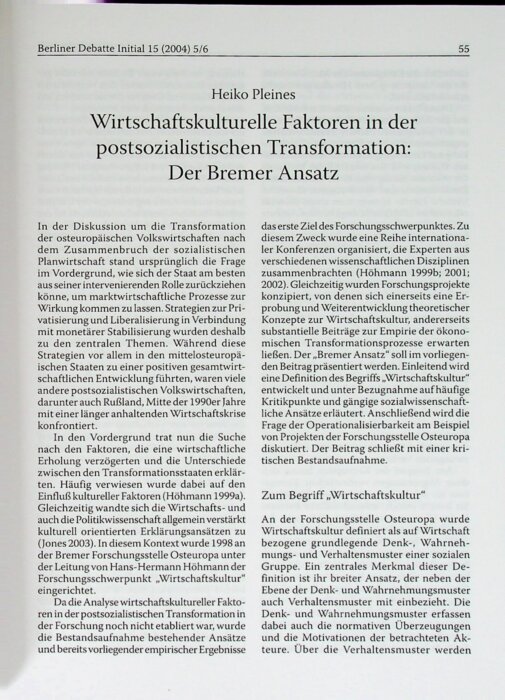
Necessary literacies are thus based on more elaborated forms of reading skills: comprehension of complex political issues and deliberatively building political opinions require skills like abstraction, reflection, distancing, and critical thinking. [29] Political reading likewise differs in terms of the outcomes of information and persuasion reaching target audiences characterized by a capacity to comprehend not only political content, but also the ways in which content is presented by its usable objects. [30]
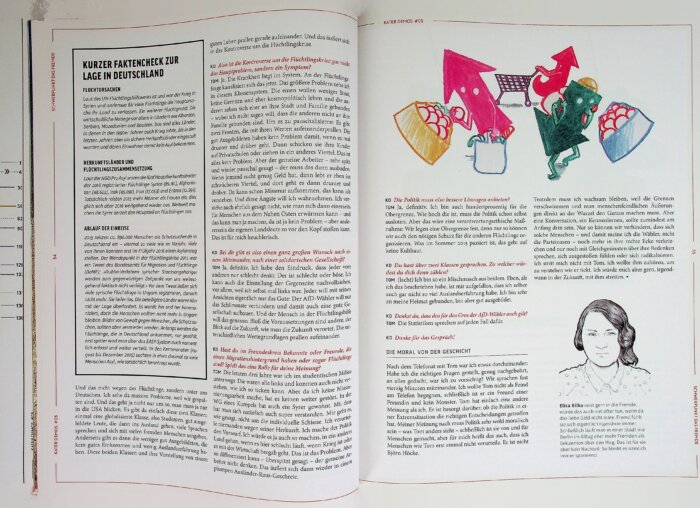
One common feature of political reading objects in this regard is their non-linearity, allowing readers freely to choose what to read or not to read, and to read in the order they prefer. [31] Although political reading processes may occur in a linear fashion, as is the case when reading a written political text from start to finish, it is non-linear modes, skimming through political reading objects and content, and hybrid modes of reading, alternating continuous and discontinuous reading processes, that are the dominant political reading practices, ambiguously supported by the materiality and visuality of political reading objects. [32] Political reading objects usually offer many political content elements at once, within any particular article, in the incorporation of several articles on any given page or two-page spread, and in each issue. This is exemplified in this spread from Kater Demos (Fig. 2), which shows several reading elements: interview questions and answers marked by color, a resumé marked by a headline, a frame-lined text on the left with another three separate textual units marked by bold headlines, an illustration, and a short biography with graphical portrait of the interviewee.
According to Bonfadelli, Dörner, and Vogt, political reading can further be analytically divided into (1) seeking political information in reading objects and, (2) using reading objects to interpret political information for the sake of opinion formation. [33]
(1) Obligatory, instrumental, and conceptual political reading strategies [34] are motivated by the need to learn about political interrelations, being pragmatic about using political information, or by an interest in policies overall; motivations of this sort emphasize efficient and effective reading strategies for political knowledge gain, for making use of political information in other practices, or for gaining insights into and understanding of political issues. This is accompanied by rational expectations that the political information is accessible and intelligible, that the political content is suitable, and that both are adequately presented in reading objects. Evaluating political information when reading occurs based on the attribution of relevance, authenticity, and reliability of the information presented; these are the highest values for political knowledge. [35] Given the information asymmetry between readers and political agents offering political reading objects (who either have or pretend to have resources and insights into politics which readers do not have), images of professionalism, expertise, and objectivity are expected and take on value in political reading practices, [36] as do certain intentions on the part of editors and authors (‘wants to convince me,’ ‘wants to spread an ideology,’ ‘wants me to understand,’ ‘wants to give me a voice in public’ etc.). This is exemplified here by Merkur, which offers an editorial as verification of its professional production (right), a list of contributors for displaying expertise (left), and which emphasizes its integration of multiple perspectives in its self-portrayal (Fig. 3). Informational reading strategies are thus focused primarily on cognitive effects like comprehensible reasons, and consequences of political issues, which are supported primarily by user-friendly, and therefore widely standardized and expected political reading objects like newspapers, political magazines, political blogs, etc.
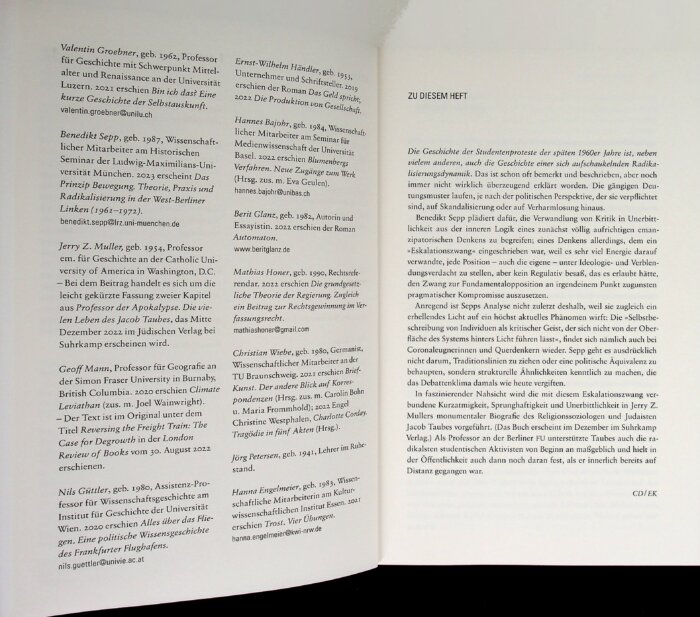
(2) In comparison, discursive political reading strategies [37] emerge when a reader is trying to build or confirm an opinion about political issues, and when expanding informational reading strategies by reader dispositions. These strategies are structured in such a way as to individually (re-)construct political interrelations, arguments, opinions, and suggestions, with the effect of drawing individual conclusions regarding political identity and activities. Incorporated reading strategies then involve affective activation, imagining what-if scenarios and alternatives, and distinguishing one’s own political ideation from other political opinions, ideologies, movements, organizations, etc. Reading objects are then primarily used for experiencing emotions, moods, and attitudes for the sake of consolidating political identity, being a part of a political community, or becoming involved in certain political activities like elections, debates, protests, or revolutions. [38]
Emotions associated with political reading are thus often related to personal experiences of political issues in everyday life; these experiences are processed, amplified, or exhausted by reading objects. Reader expectations are associated with designs that lend the information specific meanings and which have certain effects on evaluation, thereby re-formulating political issues into political narratives to either question or to follow. This becomes especially apparent in magazines like Cato, which presents political issues by a dominant right-wing political ideology, here by a conservative framing of the ongoing conflict between Russia and the United States, picturing a ‘solution’ which relies on powerful men, and military (Fig. 4).
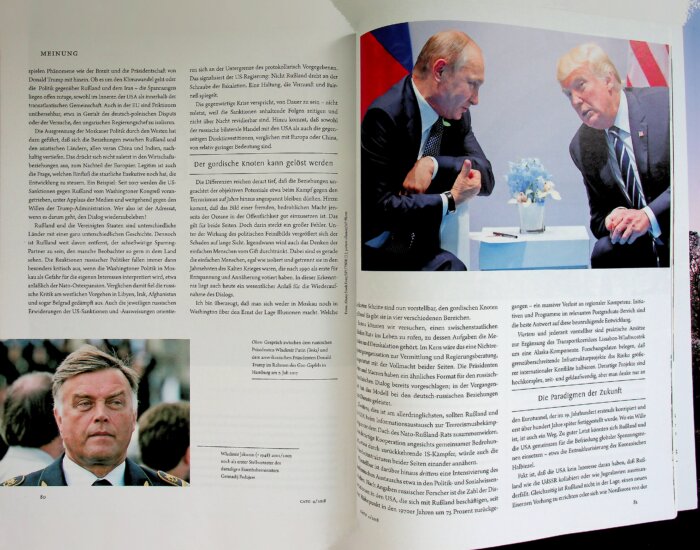
In other words, political reading includes an awareness of efforts by the presenter to persuade the reader to adopt a certain political attitude, identity, or behavior. [39] Political attitudes, defined as stable tendencies of cognitive and affective evaluation of political issues, ideologies, reading objects, or political agents, [40] therefore alter political reading by evoking acceptance, approval, or dismissal of content and opinions presented. This is confirmed by political communication research: although people may choose from a variety of political media, they will decide to use those media objects which will confirm their own political attitudes and opinions. [41] Thus, linking available political and reading literacies to political attitudes also determines whether offered political opinions are simply adopted, or are amplified, evaluated, or re-interpreted. [42] This makes political reading particularly vulnerable to the narrowing and constant reaffirmation of already held political identities rather than enabling (normatively requested) opinions to be transformed by debate and argumentation. [43]
3.2_Political as Reading Artifacts
The underlying, but not elaborated meaning of political reading objects in political communication can be further developed by considering their materiality, opening up a range of sensibilities in political reading practices. [44] This requires understanding political reading media as intermediate states of political communication, in which political information, persuasion, and activation are negotiated through technical, material, visual, and semiotic means. [45] Political reading objects then are always read (and used) as material and interactive political reading artifacts, partially enabling, organizing, or restricting mental activities of political communication. [46] Political reading artifacts thereby act as powerful affordances [47] and performative physical presences, [48] which identify their content as political in nature, inviting the adoption of certain perceptual modalities and physical activities, and anticipating certain expectations relating to design, the reading processes invoked, and the gratifications to be gained (Fig. 5). [49]
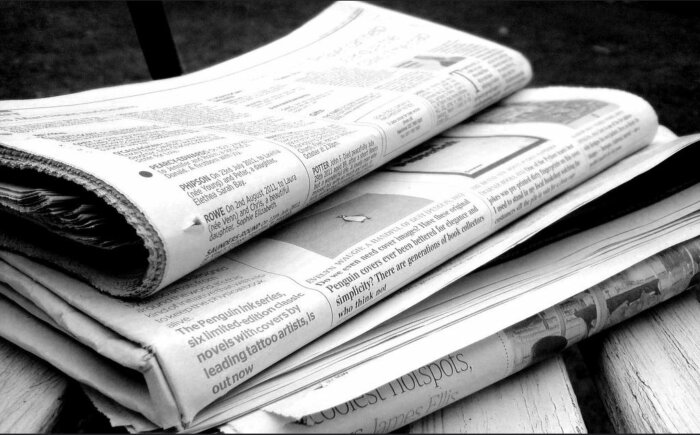
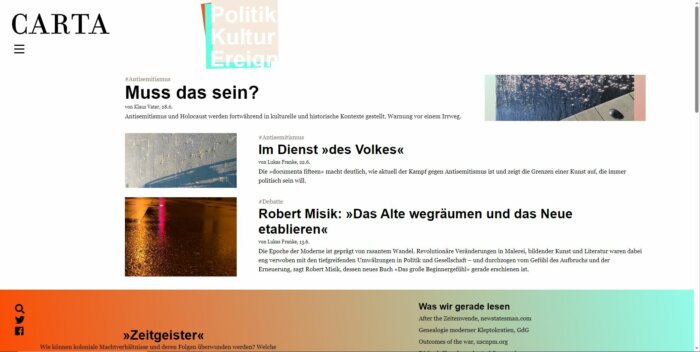
Distinguishing political reading from other ways of reading then has to do with intersubjectivity [50] and is defined as collectively incorporated conceptions of typical political reading objects related to one another by their communicative and material features, that are routinely used and experienced in similar ways via cultural agreement. [51] Political reading artifacts are thus results, expressions, and prerequisites of culturally and historically situated political reading practices, out of which certain perceptions of political content, information, persuasion, and activation emerge. [52]
Of primary consideration are those material aspects of political reading objects that are sensorially experienced, such as paper, ink, and glue for printed artifacts, or plastic, metal, and glass for digital artifacts. Materials and their combinations suggest particular kinds of usability, validity, and quality, and are associated with specific reading situations (e.g., the daily newspaper), spaces (e.g., the home), or times (e.g., in the morning). Materials present not only physical differences in political content presentation by properties, quality, or format, [53] but also make for certain haptic experiences [54] and perceptions of visual modes of presentation when reading. [55] For example, the use of uncoated paper defines potential page formats in terms of size and shape, limiting the number of political content elements that can be perceived at once; facilitates the legibility of the written language by low light reflection, leading to better comprehension of political issues; and at the same time makes turning the pages more comfortable, adding to a positive evaluation of the opinions presented.
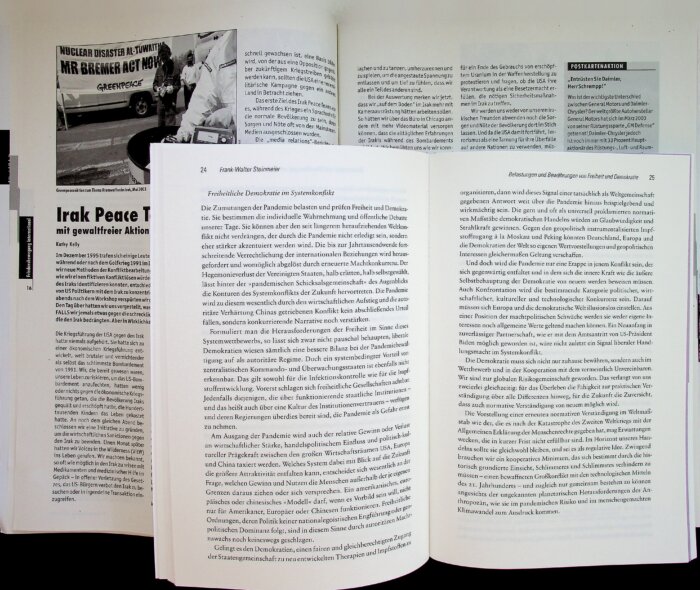
Materials and their combinations inherit historical cultural values, appreciations, and symbolic meanings; they affect political reading practices by creating certain reading atmospheres, which imply relevance, authenticity, and reliability of political information, and which validate the presented political opinions and attitudes. Compare, for example, the bookish format, high quality uncoated paper with high opacity and pleasant haptics offered by Merkur to FriedensForum’s low-quality recycled paper in DIN A4 (Fig. 6): here, supported by historically developed evaluations of printed books as the most valuable media for imparting ‘true’ knowledge, Merkur deliberately uses its format to subconsciously enhance its readers’ perception of the relevance, importance, truth, or rightfulness in the content it presents.
In this regard, materiality in political reading becomes mediality, which contextually affects reception, reading behavior, and the evaluation of political content. [56] Materials have semiotic value, [57] making them an essential part of political information, persuasion, and activation. Reading “is not a material transfer but a mental transfer aided by materiality,” [58] which may be used by political agents to communicate certain intended meanings or to build relationships with their readers by indicating attitudes, power, or status, [59] and altering both informational and discursive reading strategies. [60] Materiality thus always refers to its political contextualization, and its code is not static: in a Marxist magazine, low paper quality may symbolically reference a poor working class milieu, but in another magazine may simply indicate a lack of financial support.
Reading Material Artifacts as Images and Typography
Specific material configurations and their semiotic meanings point to certain processing and perceptions of sign systems in political reading. [61] Although its mutual effects have barely been analyzed, [62] political reading is aimed not only at comprehending written texts related to politics, but at meaningful combinations of multiple modalities, [63] which can be empirically typified and interpreted as distinct political reading patterns and effects. [64] Political reading thereby includes reading artifacts figuratively as forms of expression of political issues, and as encoding and decoding them by design based on political ideologies. [65] Figurations [66] of political reading artifacts are widely standardized; easily recognizable as ‘political,’ their forms therefore incorporate expectations that activate and structure political reading practices. Here, this typical bookish structure is exemplified by double-page spreads used for political essays from Merkur, Widerspruch, Blätter für deutsche und internationale Politik, and Gegenstandpunkt, which point to typical German political magazines and text types from the 1970s onwards (Fig. 7).
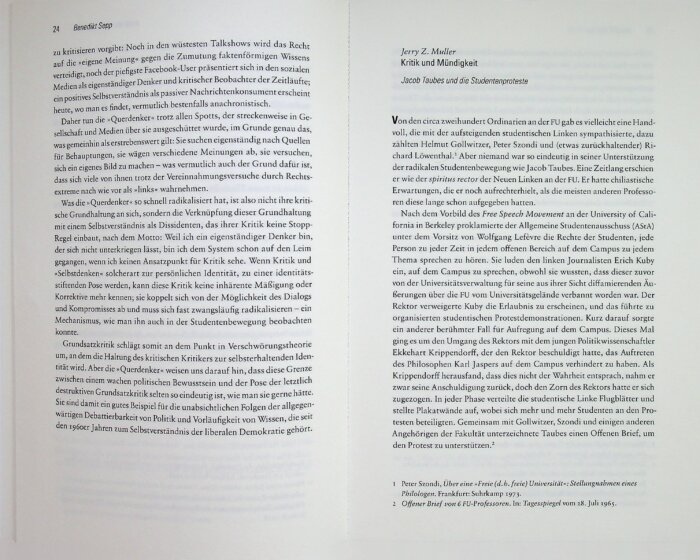
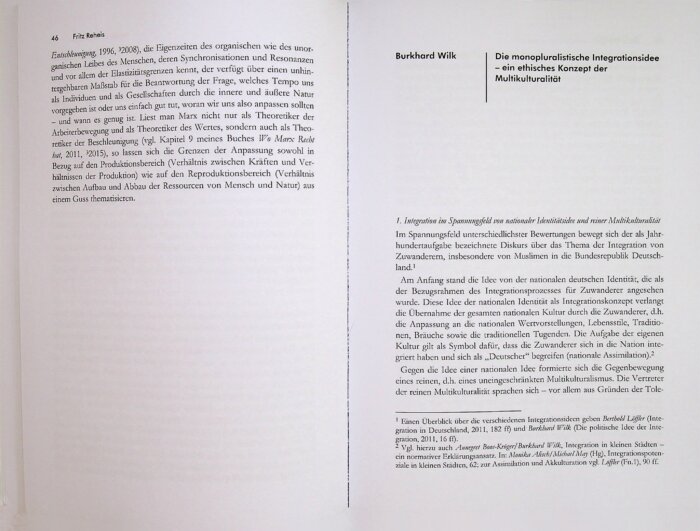
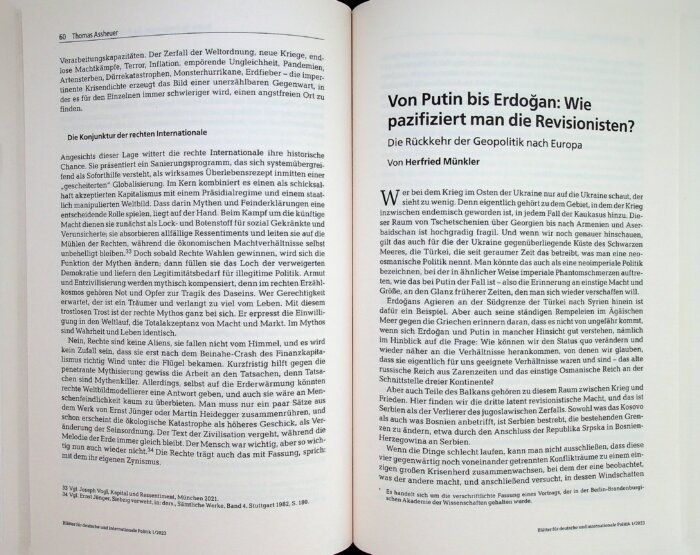
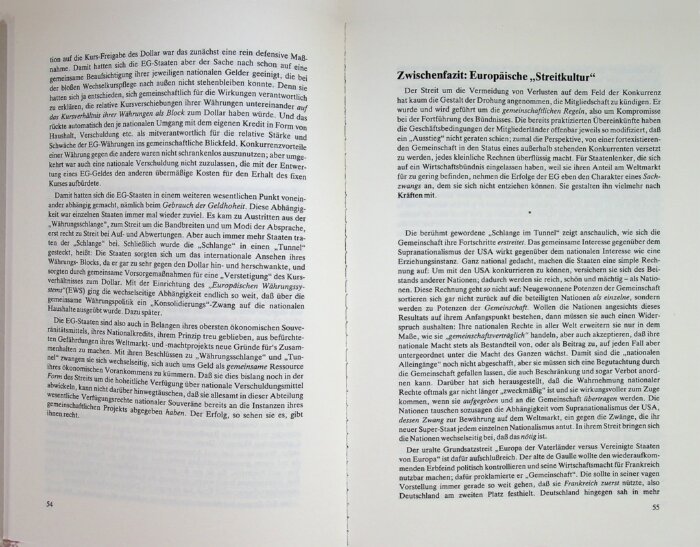
Figurations in political reading refer to the physical (visual, tactile, auditive, and olfactory) perception of political reading artifacts in certain situational contexts and spatial constellations, which usually starts with the material object in its entirety, cascading down to the perception of (double) pages or screens, and of materialized content units when browsing or reading. [67] The modalities that are combined then are materiality, verbal language, written text, and pictures, which are read in continuous transposition of their meaning. [68]
Verbal language in political reading artifacts is conventionalized in typical text types (e.g., report and reportage in newspapers, essay and interview in political culture magazines, commentary and apostille in political blogs), text structures (e.g., by sequences of describing issue and reason, evaluation, and problem-solving), or rhetoric (e.g., analytical, argumentative, agitational), offering political information, persuasion, or activation by predictable wording. Written text materializes verbal language and is itself already a multimodal composition of verbal language, as it displays phonetics by visual signs or text types by expectable visual structures of words, sentences, or passages. Written language in political reading is referenced as narration and logical argumentation, and is therefore, especially in western cultures, still more associated with authenticity and reliability than are other modalities. It is primarily used to activate political memories, experiences, knowledge, or mental schemes in order to conceptualize logic of political issues, to establish a relationship between political agents and readers, and to structure political messages. Pictures, however, may also be used for this, though they involve many interfering aspects, which activate perception modes either improving political information processing or initiating affective effects by way of implicit expressions and pleas. They are often associated with documenting or illustrating something plainly in a spatial context, or with emotional activation, [69] in political contexts often falling back on similar and expectable motives, perspectives, or moods, which suggest incorporated political meanings for certain issues, evaluations, or ideologies. Political culture magazines, for example, all use the essay as primary text type, thereby already symbolically indicating their function in opinion formation and persuasion. Illustrations in political reading artifacts are often portraits of politicians, used to symbolically personalize and evaluate political issues, here exemplified by the contrasting depictions of Angela Merkel on the cover of politically left-wing lunapark21 and politically right-wing Krautzone (Fig. 8).
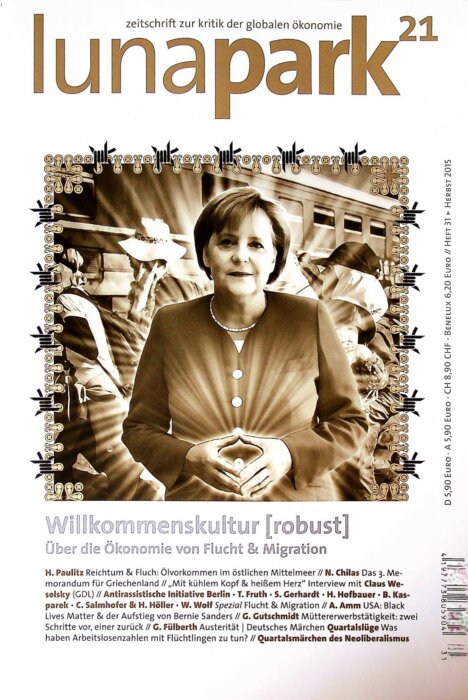
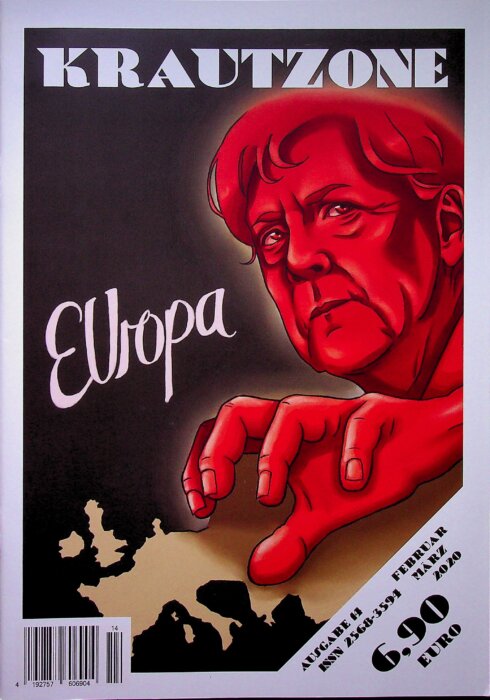
When engaging political reading artifacts and their surfaces, combinations of all modalities are read as a continuous stream of indistinct holistic impressions and associations within each modality at once. [70] All perceptions thereby collapse into one vague mental representation, which initiates and guides reading strategies and practices in three different ways. First, images identify and unlock the political content even before any reading of the written text. Second, images organize understanding and comprehension with the indication of needed literacies and political knowledge. And third, images frame political developments or agents affectively, affecting the evaluation of political issues and opinions. [71] All modalities mutually add content, increase functionality, or influence meanings, [72] thereby strengthening or weakening their individual effects on political information, persuasion, or activation as well as indicating intended reader groups or associated political communities. [73] This can be exemplified by the cover and double page of Cicero, the former setting the tone for evaluating up-and-coming young conservative politicians in this issue, the latter evoking positive emotions via a photo of pandas, related to an unconstrained typeset which then lingers in maximal contrast to the written text’s negative political portrayal of China (Fig. 9).
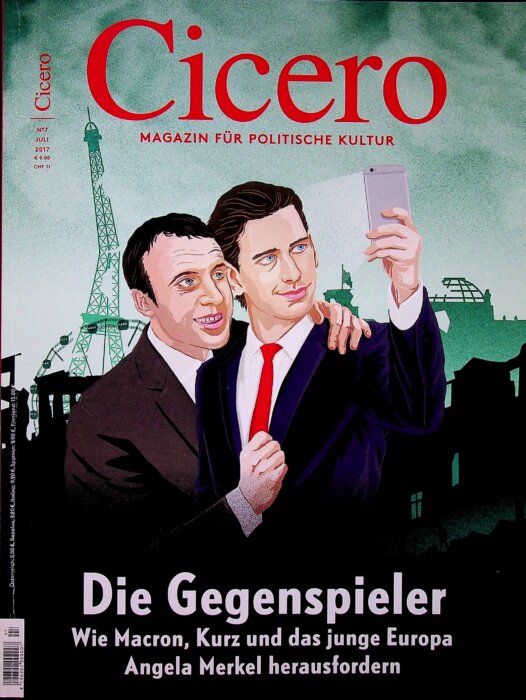

Reading figuratively therefore refers to reading certain incorporated typographical types of presented political content, [74] creating political meaning by themselves and by transforming the meanings of verbal language and pictures, [75] as well as by linking certain reading modes to each type. Typography at first enables political reading by aiming at legibility and readability, which also ensures comprehensibility of the political messages. Letters must be designed to be identifiable (nano-typography), their composition in words and lines must be organized for successful perception (micro-typography), and text arrangements including all modalities must be composed for easy navigation and comprehension (macro-typography). [76]
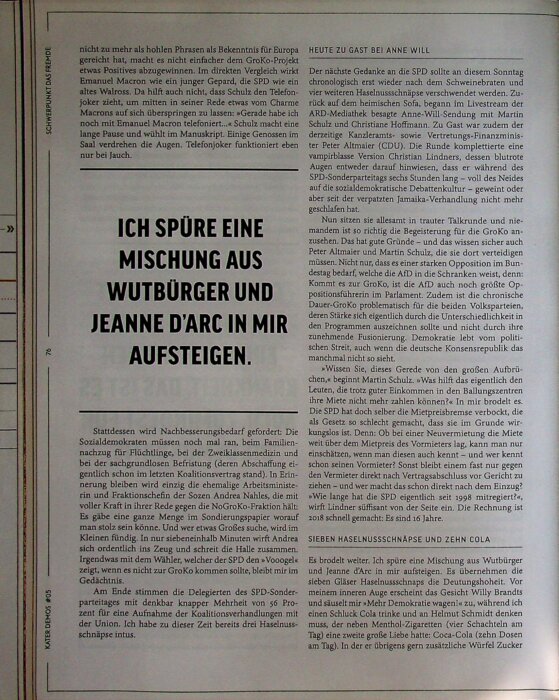
In its spatial configuration, typography first suggests reading sequences and hierarchies of the modalities used. Variations may then be used for initiating certain reading strategies for the political information presented, directing comprehension and salience. In contemporary political culture magazines, usually two typefaces are used, one (most often sans serif) for paratextual elements and one (most often renaissance or classical Antiqua) for running text, both aiming at maximizing legibility and readability. In Kater Demos, an upper-case sans serif typeface in bold markup is used for highlighting statements, suggesting reading strategies by attention created and salience of content elements by connotations of importance and weight. The renaissance Antiqua used for running text in comparison has fewer obvious connotations other than appearing a standardized font for maximum legibility and readability (Fig. 10). Reading strategies then include sequential deep reading guided by organizing visual elements (‘bookish’ reading, see Fig. 7) for gaining insight into and understanding political issues; erratic reading, led by salient elements (‘ideological’ reading) for political persuasion; and free reading (‘interactive’ reading) for political information related to interest (Fig. 11).

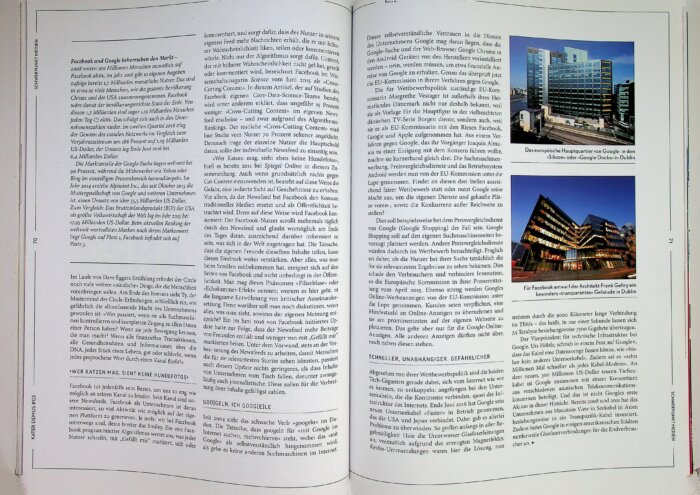
Variations in typography may also be used to manipulate thinking about political content by creating expectations, setting perspectives, or offering orientation for political identities. Conceptual typographical patterns, which are based on certain structures, classes of elements, topology, and symbols, represent intended hierarchies and judgements of political agents or persons concerned, culprits, opinions, and arguments. Narrative typographical patterns, which are based on shape, position, and orientation of visual elements, add temporal attributes to political issues, which suggest certain sequences of political events. Additionally, narrative typographical patterns indicate dependencies of actions and agents, which influence the readers’ political opinions and attitudes. Finally, interactive typographical patterns are used to shape the relationship between the political agents offering the reading object and its readers. Visual elements are used to address readers by perspective, gaze, closeness or distance, angles, etc., to create involvement, affect, or personal significance.
Nano- and micro-typography are structured primarily by the physical requirements of visual perception and allow only small design decisions for subtle political connotation, [77] such as fonts that characterize political content and mark-ups for indicating the importance of reasons or arguments, spacing the text in ways that suggest balance, delimitation, concision, or even (dis-)harmony of political content and argumentation. Macro-typography, on the other hand, also indicates certain conceptions of politics and political ideology and addresses political experience and knowledge of certain target audiences. [78]
As typography is sensitive to contexts, its concrete patterns are not grammatically structured but reflect historical political ideologies or affiliations with certain political groups, communities, or movements, as can be easily seen by the cover figurations of LuXemburg, die Internationale, and Sozialismus (Fig. 12). [79] This also indicates that political reading practices are targeted by political agents, used in certain material constellations, modality combinations, content arrangement, or visual design, organizing not only political reading processes by legibility and readability, but also by orchestrating the interpretation of political issues between producer and reader [80] by way of affective design, e.g., by portraying politicians as heroes or villains, [81] or by valuing certain political decisions as seminal or dangerous. In this regard, typography also becomes crucial for attributions of authenticity and reliability, which some political communities acknowledge and some deny, legible in form and design. [82]
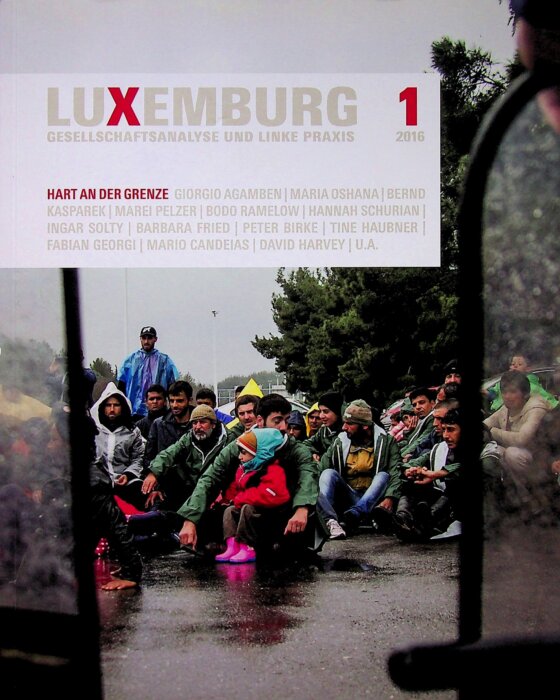
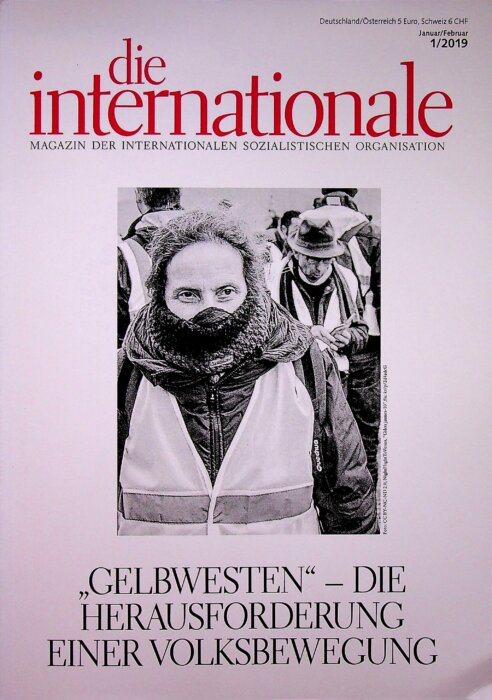
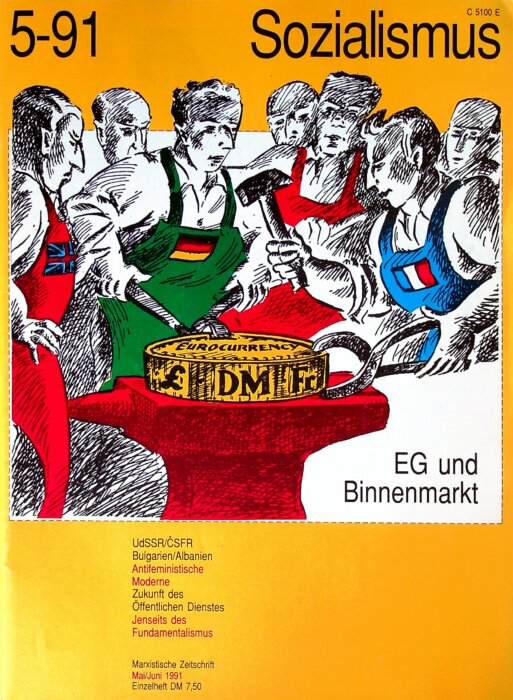
4_Conclusion
Political reading is at first sight not fundamentally different from other reading practices, but is instead a complex and typical variation of media communication orienting political identity, activity, and knowledge. It refers to communicative interactions between political agents, political reading media, and readers; [83] it restricts its referenced information to political content; [84] and it focuses its impact on political participation. [85] One defining aspect of political reading thus is the ongoing evaluation of political information and opinions by the attribution of relevance, authenticity, reliability, and its presentation based on subjective expectations of professionalism, objectivity, and persuasion. Political reading thereby is never only decoding letters or political text, but always the construction of political meaning by combinations of materiality, figurations, modalities, and political content in signifying political reading practices. [86]
But how do people choose a particular political way of reading in a given situation? Using an interdisciplinary approach, this article argued that political reading practices occur when certain reading objects are consciously and unconsciously identified as ‘political’ by purpose and design. This kind of perception then is based on many interrelating parameters of political communication and material reading practices, indicating why and how to read politically. [87] Political reading artifacts thereby act as powerful material and semiotic affordances by design, initiating certain political reading practices. They suggest, enable, and organize certain physical reading activities, and invite certain political reading demeanors and strategies, as well as anticipate certain expectations regarding the political content, reading experiences and gratifications. At the same time, political reading objects refer to a certain usability, validity, and quality of political information and opinions, indicated by the materiality, figurations, and typographical patterns perceived when reading. These modalities in turn mark reading objects and content as political, evoke political reading practices and strategies, improve or restrict political information, activate readers by affective contextualization, and guide reading by creating expectations, perspectives, and orientations framed by political attitudes and ideologies.
Limitations
Political reading, as a unique way of reading as discussed in this article, refers at first to a simplified descriptive model, which can be used to gain more knowledge in empirical research but cannot display its full complexity and variety for purposes of reasoning and explanations. [88] Second, political reading is discussed theoretically by combining different (sometimes even contradictory) approaches to reception analysis and by exemplifying results with temporary data from an ongoing project. Deductions drawn regarding political reading therefore have not been confirmed by empirical studies of political reading practices, which is also a challenging task for the future because of missing empirical methods. Finally, this article used a more traditional model of political reading focused on writing and static pictures. Although this model still dominates political communication, digital media expand modalities with moving pictures, interactive elements, interpersonal communication tools, and augmented or virtual reality environments, which must be included in future empirical research.
_How to Cite
Axel Kuhn. “’Political Reading Artifacts: A Conceptual Approach on Characterizing a Certain Way of Reading.” On_Culture: The Open Journal for the Study of Culture 16 (2024). <https://doi.org/10.22029/oc.2024.1403>.
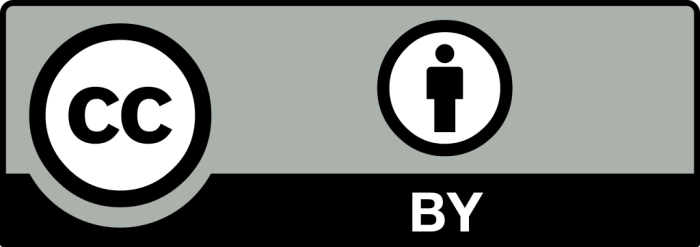
_Endnotes
- [1] Heinz Bonfadelli, “Politische Implikationen des Lesens,” in Lesen: Ein interdisziplinäres Handbuch, eds. Ursula Rautenberg and Ute Schneider (Berlin/Boston: De Gruyter, 2015), 815–832, here: 815. All conclusions about political reading in this article are restricted to western democratic societies, because political communication and therefore political reading differ extensively in form and function in other governmental contextualization like autocracies or theocracies.
- [2] Maxwell R. McCombs and Paula Poindexter, “The Duty to Keep Informed,” Journalism of Communication 33 (1985): 88–96, here: 88; Paula Poindexter and Maxwell R. McCombs, “Revisiting the Civic Duty to Keep Informed,” Journalism & Mass Communication Quarterly 78 (2011): 113–126, here: 124.
- [3] For an overview see Axel Kuhn and Sandra Rühr, “Stand der Lese- und Leserforschung: Eine kritische Analyse,” in Buchwissenschaft in Deutschland: Ein Handbuch, ed. Ursula Rautenberg (Berlin/Boston: De Gruyter, 2010), 585–654.
- [4] Heinz Bonfadelli, “Lesen und politische Kultur,” Imprimatur XXVIII (2023): 291–305, here: 291. See McCombs and Poindexter, The Duty to Keep Informed, 92 for a first reference to the idea of the political as a distinct mode of reading related to newspaper reading patterns.
- [5] <https://www.politische-kulturmagazine.phil.fau.de/>.
- [6] Heinz Bonfadelli, “Entstehung und Entwicklung der modernen Lese- und Leserforschung im 20. Jahrhundert,” in Lesen: Ein interdisziplinäres Handbuch, eds. Ursula Rautenberg and Ute Schneider (Berlin/Boston: De Gruyter, 2015), 531–546, here: 543.
- [7] Judith Seaboyer and Tully Barnett, “New Perspectives on Reading and Writing across the Disciplines,” Higher Education Research & Development 38, no.1 (2019): 1–10, here: 3.
- [8] Cf. Werner Graf, Der Sinn des Lesens: Modi der literarischen Rezeptionskompetenz (Münster: LIT, 2004), 17; Christian Dawidowski, Literarische Bildung in der heutigen Mediengesellschaft: Eine empirische Studie zur kultursoziologischen Leseforschung (Frankfurt a.M.: Peter Lang, 2009), 103; Michael L. Kamil et al., “Reading Research in a Changing Era: An Introduction to the Handbook of Reading Research, Vol. IV,” in Handbook of Reading Research, Vol. IV, eds. Michael L. Kamil et al. (New York/London: Routledge, 2011), xiii–xxvi, here: xviii.
- [9] Anne Mangen and Adriaan van der Weel, “The Evolution of Reading in the Age of Digitization: An Integrative Framework for Reading Research,” Literacy 50, no. 3 (2016): 116–124.
- [10] Axel Kuhn and Svenja Hagenhoff, “Kommunikative statt objektzentrierte Gestaltung: Zur Notwendigkeit veränderter Lesekonzepte und Leseforschung für digitale Lesemedien,” in Lesen X.0: Rezeptionsprozesse in der digitalen Gegenwart, eds. Sebastian Böck et al. (Göttingen: V&R unipress, 2017), 27–45.
- [11] María Angélica Thumala Olave, “Reading Matters: Towards a Cultural Sociology of Reading,” American Journal of Cultural Sociology 6, no. 3 (2017): 417–454, here: 418.
- [12] Alexander Honold and Rudolf Parr, “Lesen: literatur-, kultur- und medienwissenschaftlich,” in Grundthemen der Literaturwissenschaft: Lesen, eds. Alexander Honold and Rudolf Parr (Berlin/Boston: De Gruyter, 2018), 3–26, here: 11.
- [13] Maryanne Wolf and Mirit Barzillai, “The Importance of Deep Reading,” Educational Leadership 66, no. 6 (2009): 32–37.
- [14] Andreas Reckwitz, “Grundelemente einer Theorie sozialer Praktiken: Eine sozialtheoretische Perspektive,” Zeitschrift für Soziologie 32, no. 4 (2003): 282–301.
- [15] Cf. for academic reading as way of reading Axel Kuhn, “Akademisches Lesen: Ein unübersichtliches Forschungsfeld,” in Akademisches Lesen: Medien, Praktiken, Bibliotheken, eds. Stefan Alker-Windbichler et al. (Göttingen/Wien: V&R unipress, 2022), 327–364, here: 330–332.
- [16] Peter Afflerbach, David P. Pearson, and Scott Paris, “Clarifying between Reading Skills and Reading Strategies,” The Reading Teacher 61, no. 5 (2008): 364–373, here: 368.
- [17] Thumala Olave, “Reading Matters,” 418.
- [18] John A. Bateman, “Dimensions of Materiality,” in Empirical Multimodality Research: Methods, Evaluations, Implications, eds. Jana Pflaegling, Janina Wildfeuer, and John A. Bateman (Berlin/Boston: De Gruyter, 2021), 35–64, here: 35.
- [19] Axel Kuhn, “Inkorporierung und Verkörperung des Buchgebrauchs,” in Das Buch als Handlungsangebot: Soziale, kulturelle und symbolische Praktiken jenseits des Lesens, eds. Ursula Rautenberg and Ute Schneider (Stuttgart: Anton Hiersemann, 2023), 83–98.
- [20] For a basic praxeological framework see Reckwitz, Grundlemente einer Theorie sozialer Praktiken; for a praxeological reading framework see Axel Kuhn and Ute Schneider, “Buchgebrauch beim Lesen,” in Das Buch als Handlungsangebot: Soziale, kulturelle und symbolische Praktiken jenseits des Lesens, eds. Ursula Rautenberg and Ute Schneider (Stuttgart: Anton Hiersemann, 2023), 31–51.
- [21] Theodore R. Schatzki, “Introduction: Practice Theory,” in The Practice Turn in Contemporary Theory, eds. Theodore R. Schatzki, Karin Knorr-Cetina, and Eike von Savigny (London: Routledge, 2001), 1–15, here: 2.
- [22] Frank Hillebrandt, Soziologische Praxistheorien: Eine Einführung (Wiesbaden: Springer VS, 2014), 59.
- [23] Stefan Hirschauer, “Verhalten, Handeln, Interagieren,” in Praxistheorie: Ein soziologisches Forschungsprogramm, ed. Hilmar Schäfer (Bielefeld: transcript, 2015), 45–67, here: 46; Raphaela Knipp, “Literaturbezogene Praktiken: Überlegungen zu einer praxeologischen Rezeptionsforschung,” Navigationen: Zeitschrift für Medien- und Kulturwissenschaften 17, no. 1 (2017): 95–116, here: 110–111.
- [24] Cf. for media objects in general Mark von Dang-Ahn et al., “Medienpraktiken situieren, erforschen, reflektieren: Eine Einleitung,” Navigationen: Zeitschrift für Medien- und Kulturwissenschaften 17, no. 1 (2017): 17–36, here: 16–26.
- [25] Nick Couldry, “Theorising Media as Practice,” Social Semiotics 14, no. 2 (2004): 115–132, here: 116–117.
- [26] Kornelia Engert and Björn Krey, “Das lesende Schreiben und das schreibende Lesen: Zur epistemischen Arbeit an und mit wissenschaftlichen Texten,” Zeitschrift für Soziologie 42, no. 5 (2013): 366–384, here: 377; Andreas Reckwitz, “Praktiken und ihre Affekte,” in Praxistheorie: Ein soziologisches Forschungsprogramm, ed. Hilmar Schäfer (Bielefeld: transcript, 2016), 163–180, here: 169; Naomi Baron, How Do We Read Now: Strategic Choices for Print, Screen, and Audio (Oxford: Oxford University Press 2021), 15.
- [27] Ursula Christmann, “Information als unmittelbare Funktion des Lesens,” in Lesesozialisation in der Mediengesellschaft: Ein Forschungsüberblick, eds. Norbert Groeben and Bettina Hurrelmann (Weinheim/München: Juventa, 2004), 61–94, here: 61.
- [28] Anna Sophie Kümpel and Julian Unkel, “Verarbeitung politischer Informationen,” in Handbuch Politische Kommunikation, eds. Isabelle Borucki et al. (Wiesbaden: Springer VS, 2020). Doi: 10.1007/978-3-658-26242-6_35-2.
- [29] Ulrich Saxer, Mediengesellschaft: Eine kommunikationssoziologische Perspektive (Wiesbaden: Springer VS, 2012), 418.
- [30] Defined as “semiotic” or “graphical” knowledge by Jürgen Spitzmüller, Graphische Variationen als soziale Praxis: Eine soziolinguistische Theorie skripturaler ‘Sichtbarkeit’ (Berlin/Boston: De Gruyter, 2013).
- [31] Hans-Jürgen Bucher, “Multimodales Verstehen oder Rezeption als Interaktion: Theoretische und empirische Grundlagen einer systematischen Analyse der Multimodalität,” in Bildlinguistik: Theorien, Methoden, Fallbeispiele, eds. Hajo Diekmannshenke, Michael Klemm, and Hartmut Stöckl (Berlin: Erich Schmidt, 2011), 123–156, here: 125.
- [32] Hartmut Stöckl, “Typographie: Gewand und Körper des Textes: Linguistische Überlegungen zu typographischer Gestaltung,” Zeitschrift für angewandte Linguistik 41 (2004): 5–48, here: 10.
- [33] Heinz Bonfadelli, Andreas Dörner, and Ludgera Vogt, Literatursoziologie: Eine Einführung in zentrale Positionen von Marx bis Bourdieu, von der Systemtheorie bis zu den British Cultural Studies (Wiesbaden: Springer VS, 2013), 219.
- [34] Graf, Der Sinn des Lesens; refined in Werner Graf, “Leseverstehen komplexer Texte,” in Lesen: Ein interdisziplinäres Handbuch, eds. Ursula Rautenberg and Ute Schneider (Berlin/Boston: De Gruyter, 2015), 185–205.
- [35] Marcus Maurer, “Medienwirkungen auf Einstellungen zu politischen Themen und Akteuren,” in Handbuch Politische Kommunikation, eds. Isabelle Borucki et al. (Wiesbaden: Springer VS, 2020). Doi: 10.1007/978-3-658-26242-6_39-1.
- [36] Maurer, “Medienwirkungen auf Einstellungen.”
- [37] Graf, Der Sinn des Lesens; refined in Graf, “Leseverstehen komplexer Texte.”
- [38] Larissa Leonhard and Anne Bartsch, “Affektive Wirkungen politischer Kommunikation,” in Handbuch Politische Kommunikation, eds. Isabelle Borucki et al. (Wiesbaden: Springer VS, 2020). Doi: 10.1007/978-3-658-26242-6_42-1.
- [39] Andreas Nanz and Jörg Matthes, “Kognitive Wirkungen politischer Kommunikation,” in Handbuch Politische Kommunikation, eds. Isabelle Borucki et al. (Wiesbaden: Springer VS, 2020). Doi: 10.1007/978-3-658-26242-6_38-1.
- [40] Maurer, “Medienwirkungen auf Einstellungen.”
- [41] Maurer, “Medienwirkungen auf Einstellungen.”
- [42] Graf, “Leseverstehen komplexer Texte,” 187.
- [43] Kümpel and Unkel, “Verarbeitung politischer Informationen.”
- [44] Ash Watson and Andy Bennett, “Why Do People Read Zines? Meaning, Materiality and Cultures of Reading,” in The Cultural Sociology of Reading: The Meanings of Reading and Books Across the World, ed. María Angélica Thumala Olave (Cham: Palgrave Macmillan, 2022), 65–89, here: 85.
- [45] Stöckl, “Typographie,” 7.
- [46] Arnulf Deppermann, Helmuth Feilke, and Angelika Linke, “Sprachliche und kommunikative Praktiken: Eine Annäherung aus linguistischer Sicht,” in Sprachliche und kommunikative Praktiken, eds. Arnulf Deppermann, Helmuth Feilke, and Angelika Linke (Berlin/Boston: De Gruyter, 2015), 1–23, here: 5; Madleen Podewski, “Zeitschriften als ‘kleine Archive’,” in Handbuch Zeitschriftenforschung, eds. Oliver Scheiding and Sabina Fazli (Bielefeld: transcript, 2022), 97–108, here: 103.
- [47] Aida Bosch, Konsum und Exklusion: Eine Kultursoziologie der Dinge (Bielefeld: transcript, 2010), 24.
- [48] Hans Peter Hahn, Materielle Kultur: Eine Einführung (Berlin: Reimer-Mann-Verlag, 2014).
- [49] Hartmut Stöckl, “Multimodalität: Semiotische und textlinguistische Grundlagen,” in Handbuch Sprache im multimodalen Kontext, eds. Nina-Maria Klug and Hartmut Stöckl (Berlin/Boston: De Gruyter, 2016), 3–35, here: 21; Janina Wildfeuer, John A. Bateman, and Tuomo Hiippala, Multimodalität (Berlin/Boston: De Gruyter, 2020), 109.
- [50] Andreas Reckwitz, “Der Ort des Materiellen in den Kulturtheorien: Von sozialen Strukturen zu Artefakten,” in Unscharfe Grenzen: Perspektiven der Kultursoziologie, ed. Andreas Reckwitz (Bielefeld: transcript, 2008), 131–157, here: 145.
- [51] Roland Posner, “Kultur als Zeichensystem: Zur Semiotischen Explikation kulturwissenschaftlicher Grundbegriffe,” in Kultur als Lebenswelt und Monument, eds. Aleida Assmann and Dietrich Harth (Frankfurt a. M.: Fischer, 1991), 37–74, here: 46; Roland Posner, “Kultursemiotik,” in Einführung in die Kulturwissenschaften: Theoretische Grundlagen, Ansätze, Perspektiven, eds. Vera Nünning und Ansgar Nünning (Stuttgart/Weimar: J. B. Metzler, 2008), 39–72, here: 39.
- [52] Hartmut Winkler, “Zeichenmaschinen: oder warum die semiotische Dimension für eine Definition der Medien unerlässlich ist,” in Was ist ein Medium?, eds. Stefan Münker and Alexander Roesler (Frankfurt, Main: Suhrkamp, 2008), 211–222, here: 213.
- [53] Thomas Bremer, “Materiality and Literature: An Introduction,” Neohelicon 47 (2020): 349–356, here: 352.
- [54] Roger Chartier, Lesewelten: Buch und Lektüre in der frühen Neuzeit (Frankfurt a. M.: Campus 1990), 12.
- [55] Stöckl, “Multimodalität,” 9.
- [56] Bremer, “Materiality and Literature,” 352.
- [57] Gunter Kress and Theo van Leeuwen, Reading Images: The Grammar of Visual Design (New York: Routledge, 2006 [1996]), 215.
- [58] Lars Elleström, “The Modalities of Media II: An Expanded Model for Understanding Intermedial Relations,” in Beyond Media Borders, Volume 1: Intermedial Relations among Multimodal Media, ed. Lars Elleström (Cham: Palgrave Macmillan, 2021), 3–92, here: 19.
- [59] Cf. Wolfgang Lukas, “Epistolographische Codes der Materialität,” in Materialität in der Editionswissenschaft, ed. Martin Schuber (Berlin/Boston: De Gruyter, 2010), 45–62, here: 48–50.
- [60] Wildfeuer, Bateman, and Hiippala, Multimodalität, 142.
- [61] Bucher, “Multimodales Verstehen,” 123; Natalia Igl and Julia Menzel, “Einleitung: Zur medialen Eigenlogik Illustrierter Zeitschriften,” in Illustrierte Zeitschriften um 1900: Mediale Eigenlogik, Multimodalität und Metaisierung, eds. Natalia Igl and Julia Menzel (Bielefeld: transcript, 2016), 11–22, here: 13; Elleström, “The Modalities of Media,” 39.
- [62] Bettina M. Bock and Pirkko Friederike Dressing, “Multimodale Lesestrategien: Eine empirische Rekonstruktion auf Basis von Laut-Denk- und Eye-Tracking-Daten,” in Medien im Deutschunterricht (2021): 1–22, here: 3. Doi: 10.18716/OJS/MIDU/2021.0.2.
- [63] Gunter Kress and Theo van Leeuwen, “Front Pages: The (Critical) Analysis of Newspaper Layout,” in Approaches to Media Discourse, eds. Allan Bell and Peter Garrett (Oxford: Blackwell, 1998), 186–219, here: 186; Ulla Fix, “Textstil und KonTextstile: Stile in der Kommunikation als umfassende Semiose von Sprachlichem, Parasprachlichem und Außersprachlichem,” in Stil: Ein sprachliches und soziales Phänomen: Beiträge zur Stilistik, ed. Ulla Fix (Berlin: Frank & Timme, 2007), 87–113, here: 87–88; Wildfeuer, Bateman, and Hiippala, Multimodalität, 8.
- [64] John A. Bateman and Tuomo Hiippala, “From Data to Patterns: On the Role of Models in Empirical Multimodality Research,” in Empirical Multimodality Research: Methods, Evaluations, Omplications, eds. Jana Pflaegling, Janina Wildfeuer, and John A. Bateman (Berlin/Boston: De Gruyter, 2021), 35–64, here: 66.
- [65] Kress and van Leeuwen, Reading Images, 2, 187.
- [66] Kress and van Leeuwen, Reading Images, 35 called these figurations itself ‘images’ and defined them as “semiotic landscapes.”
- [67] Kress and van Leeuwen, “Front Pages.”
- [68] Hartmut Stöckl, “Sprache-Bild-Texte lesen: Bausteine zur Methodik einer Grundkompetenz,” in Bildlinguistik: Theorien, Methoden, Fallbeispiele, eds. Hajo Diekmannshenke, Michael Klemm, and Hartmut Stöckl (Berlin: Erich Schmidt, 2011), 45–70, here: 45–46.
- [69] Stöckl, “Multimodalität,” 17.
- [70] Stöckl, “Sprache-Bild-Texte lesen,” 48–49.
- [71] Bettina M. Bock, “Makrotypografie als Verständlichkeitsfaktor: Empirische Studie zum Erkennen von Textsorten am Beispiel der ‘Leichten Sprache’,” Zeitschrift für angewandte Linguistik 73, no. 1 (2020): 181–212, here: 186.
- [72] Stöckl, “Sprache-Bild-Texte lesen,” 55–56.
- [73] Kress and van Leeuwen, Reading Images, 3.
- [74] Jürgen Spitzmüller, “Typographie: Sprache als Schriftbild,” in Handbuch Sprache im multimodalen Kontext, eds. Nina-Maria Klug and Hartmut Stöckl (Berlin/Boston: De Gruyter, 2016), 99–120, here: 102; Bock and Dressing, “Multimodale Lesestrategien,” 187.
- [75] Fix, “Textstile und KonTextstile,” 97–98.
- [76] Martin Tiefenthaler, “Zuerst liest der Körper, dann der Geist,” in Lesbar: Typografie in der Wissensvermittlung, eds. Ulrike Borinski and Rudolf Gorbach (Zürich: Triest, 2019), 21–38, here: 28–29.
- [77] Susanne Wehde, Typographische Kultur: Eine zeichentheoretische und kulturgeschichtliche Studie zur Typographie und ihrer Entwicklung (Tübingen: Niemeyer, 2000), 78–79; Tiefenthaler, “Zuerst liest der Körper,” 34.
- [78] Stöckl, “Typographie,” 24–25.
- [79] Stöckl, “Typographie,” 7–8.
- [80] Christof Windgätter, “Vom ‘Blattwerk der Signifikanz’ oder: Auf dem Weg zu einer Epistemologie der Buchgestaltung,” in Wissen im Druck: Zur Epistemologie der modernen Buchgestaltung, ed. Christof Windgätter (Wiesbaden: Harrasowitz, 2010) 6–50, here: 24.
- [81] Kress and van Leeuwen, “Front Pages,” 200.
- [82] Kress and van Leeuwen, Reading Images, 155.
- [83] Fix, “Textstile und KonTextstile,” 90–91; Elleström, “The Modalities of Media,” 14–15.
- [84] Maurer, “Medienwirkungen auf Einstellungen.”
- [85] Bertram Scheufele, “Politische Medienwirkungen auf Mikro-, Meso- und Makroebene: Problemaufriss und Klassifikation für das digitale Zeitalter,” in Handbuch Politische Kommunikation, eds. Isabelle Borucki et al. (Wiesbaden: Springer VS, 2020). Doi: 10.1007/978-3-658-26242-6_36-1.
- [86] John A. Bateman, “Methodological and Theoretical Issues in Multimodality,” in Handbuch Sprache im multimodalen Kontext, eds. Nina-Maria Klug and Hartmut Stöckl (Berlin/Boston: De Gruyter, 2016), 36–74, here: 39.
- [87] Bock, “Makrotypografie als Verständlichkeitsfaktor,” 185–186.
- [88] Bateman and Hiippala, “From Data to Patterns,” 67.


